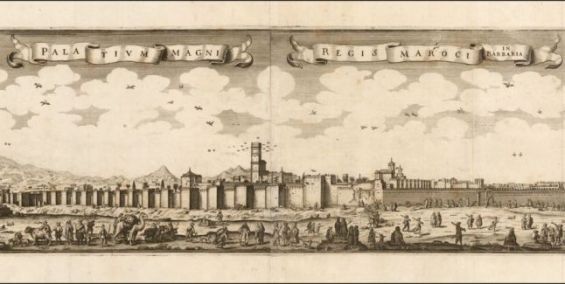In 1640, during the reign of Saadi sultan Mohammed Al-Sheikh Al-Sharif, a diplomatic mission visited Marrakech to negotiate the redemption of the crew of a Dutch ship seized by Moroccan corsairs.
The Dutch embassy, which sailed from the Netherlands to Morocco, was led by Dutch sea captain and ambassador Antonius de Liedekerke and was composed of several personalities, including Golden Age painter and engraver Adriaen Matham.
During his stay in Marrakech, Matham’s «task was to keep a record of the mission, in words and in pictures», historian Thorsteinn Helgason recalled in his book «The Corsairs’ Longest Voyage : The Turkish Raid in Iceland 1627» (BRILL, 2018).

In addition to his mission as a member of the Dutch embassy, the painter had the chance to set foot in one of the most beautiful palaces Saadi sultans resided in. According to the book of Quentin Willbaux, «Marrakech: le secret des maisons-jardins» (acr edition, 1999), the opportunity to visit the Badi Palace presented itself when the Dutch mission, sent by the lords of the Estates General of the United Netherlands, was received by Moulay Mohammed Al-Sheikh.
The eighth wonder of the world
In awe at the Moroccan palace and the kasbah, Matham spent his time in Marrakech «making a few drawings of the city», Willbaux recalled. «When he returned to the Netherlands, he made an engraving based on his drawings, which has remained famous», the same source said.
The engraving, which gave an overview of the Medina built by the Saadis and the palace, was accompanied with a notice and a narrative that Matham wrote to record his journey in the Kingdom.
 Marrakech in 1640 by Dutch painter Adriaen Matham. / Ph. DR
Marrakech in 1640 by Dutch painter Adriaen Matham. / Ph. DR
In the note that came with the engraving of Marrakech, Matham wrote that the «royal court of Morocco (Marrakech) (…) is a palace without equal». Giving a detailed description of the Badi palace, Matham said in his 1640s note that : «(the palace) greatly surpasses both in size and in the sumptuousness and splendor of the building, all that can be found, and should consequently not only be considered the eighth wonder of the wonders, but also should be known and named as the wonder of the wonders».
Matham, who was able to visit the royal court in Marrakech three times, was impressed by the tower of the building, which to him was «built with such industry and practicality» that the king could climb it while riding his horse.
«We had a great desire to examine the structure within it, but when (…) we were not allowed to set foot inside their temples or towers, since it this was not permitted to any Christian», the Dutch painter said, referring to the palace’s mosque he was dying to visit from the inside.
The three golden apples
Moreover, Matham wrote in his account that the palace had marble pillars, large gardens, and ponds. He had even reported that the Badi Palace was built by «Christians a long time ago».
In addition to the big tower, mentioned in his note, the engraver stated that the palace had a second tower to it that was «decorated on top with three apples made of massive gold, which are said to weigh together about seven hundred pounds (around 317 kilograms)».
 The ruins of the Badi Palace in Marrakech. / Ph. DR
The ruins of the Badi Palace in Marrakech. / Ph. DR
Making mention of this masterpiece, Matham said that «the Moors wanted [him] to believe that these three golden apples were under the spell of a sorcerer and that the evil would break the neck of those who would take them down». In addition to marble and gold, the Saadi royal court was home to a herd of camels, which were brought during the day to eat grass.
Although Matham was impressed by the beauty of Marrakech and the royal palace, he refused to stay in Morocco and work for the Saadi sultan.
«I and another painter from Antwerp (Belgium) were requested in the name of the King to stay there, with the promise of one ducat each day until retirement», recalled the Dutch painter who turned down the offer sailing back to the Netherlands at the end of his diplomatic mission.





 chargement...
chargement...













